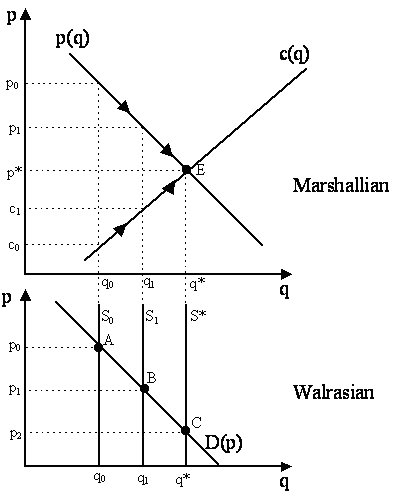Walrasian
cum Marshallian |
 |
It is common to juxtapose Walrasian and Marshallan adjustment mechanisms in contrast to each other. Presumably, they "tell" different stories, but, in fact, as Peter Newman (1965: p.106-8) has argued quite convincingly, they are not "alternatives" to one another but actually different parts of a single Neoclassical dynamics.
To understand why, let us recall our brief discussion above. From what was said, it seems that the Marshallian adjustment process has slightly more credibility than the Walrasian. In the Marshallian system, we at least know who is changing the quantities and what their incentive for doing so is, e.g. peach-farmers who want to make greater profits by becoming apple-farmers instead. In the Walrasian case, the auctioneer remains a thorough and dubious fiction.
But if we think about the details of the Marshallian adjustment process, we will quickly see that something is amiss. In particular, when in disequilibrium, quantities rise first and then, in response, demand and supply prices move. But isn't it true that Marshall, no less than Walras, assumed that, under conditions of perfect competition, consumers and firms are price-takers? So how exactly does it happen that prices respond to quantities in the Marshallian stability analysis?
In his brief review, John Hicks (1939) concluded that the Marshallian adjustment is "nearer the stability condition appropriate to conditions of monopoly than that appropriate to conditions of perfect competition." (Hicks, 1939: p.62, f.1). Paul Samuelson (1947: p.264) just regarded them as "alternatives", and went little further than that.
However, as Peter Newman (1960, 1961, 1965: p.106-8) has pointed out, this is a rather rash and unfounded conclusion. The Marshallian system of adjustment, Newman argues, is not an "alternative" to the Walrasian system. Rather, both Walras and Marshall had exactly the same adjustment process, which involved both the "Walrasian" Law of Excess Demand and the "Marshallian" Law of Excess Profitability. They just preferred to emphasize different aspects of it. In particular, Newman argues that for both theorists, the Walrasian adjustment process was seen as applicable to a pure exchange economy while the Marshallian process was invoked in a production economy. Marshall employed Walrasian logic when discussing pure exchange, while Walras employed Marshallian logic when analyzing production economies.
Newman accuses later commentators of creating an artificial and non-existent distinction between Walras's and Marshall's stability theories. The source of the confusion, he speculates, is perhaps that Walras never bothered to draw the supply-and-demand diagram for a production economy and Marshall never drew one for a pure exchange economy. But, in their verbal discussions, Walras and Marshall allowed for both adjustment processes. Later writers just never looked carefully beyond the pictures.
For textual evidence, one merely need look in Léon Walras for a Marshallian "Law of Excess Profitability". As he explains in a letter to Ladislaus Bortkiewicz, his intentions were to "demonstrate that the operations of the raising and lowering of prices, of the increase and decreases of the quantities of products produced, etc. on the markets are nothing other than the solution by tâtonnement of the equations of exchange, of production, and of capital formation." (Walras, 1889). One finds it also blatantly explicit in his discussion of production:
"In order to work out as rigorous a description of the process of groping [towards equilibrium] in production as we did in exchange and yet to take this additional circumstance into account, we have only to imagine, on the one hand, that entrepreneurs use tickets ["bons"] to represent the successive quantities of products which are first determined at random and then increased or decreased according as there is an excess of selling price over cost of production or vice-versa, until the selling price and cost are equal." (Walras, 1874: p. 242)
Or, even more explicitly at an earlier point:
"In fact, under free competition, if the selling price of a product exceeds the cost of the productive services for certain firms and a profit results, entrepreneurs will flow towards this branch of production or expand their output, so that the quantity of the product [on the market] will increase, its price will fall, and the difference between price and cost will be reduced; and if [on the contrary], the cost of the productive services exceeds the selling price for certain firms, so that a loss results, entrepreneurs will leave this branch of production or curtail their output, so that the quantity of the product [on the market] will decrease, its price will rise and the difference between price and cost will again be reduced." (Walras, 1874: p. 224-5)
A description of a Marshallian adjustment process could not be made clearer than this! [For more textual evidence, see Walker (1987, 1996) and Kompas (1992)].
Alfred Marshall, too, accepted the Walrasian "Law of Excess Demand" in a pure exchange economy, as we find throughout Chapter V of Marshall's Principles. "To go over the ground in another way. Market values are governed by the relation of demand to stocks actually in the market; with more or less reference to future supplies." (Marshall, 1890: p. 309). More explicit textual evidence can be found in Marshall's other writings (e.g. Marshall, 1879). But the main piece of evidence that Marshall entertained both adjustment processes is just plain logic. All we need to do is examine Marshall's theory carefully. We borrow here the interpretation of Ragnar Frisch (1950) and Peter Newman (1960, 1961, 1965).
Consider Figure 7, where we have two demand-and-supply diagrams -- a "Marshallian" in the upper quadrant, and a "Walrasian" in the lower quadrant. In the former, we have p(q) and c(q), the "Marshallian" demand and supply functions. At the given initial quantity, q0, demand price p0 exceeds supply price c0. By the Marshallian adjustment mechanism, we should see a rise in quantity from q0 to q1, which will raise the supply price from c0 to c1 and decrease the demand price from p0 to p1.
But why? The dynamic along the supply curve from c0 to c1 is itself suspect, but one can appeal to the Marshallian theory of the firm and its implied cost externalities, etc. But even more obscure is the movement down the demand curve. Why does demand price fall as quantities increase? This movement down the demand curve is not consistent with the assumption that consumers are price-takers.

- Neoclassical Dynamics, Long Run and Short-RunFig. 7
The easiest resolution is to recognize that, in fact, p(q), is not really a "demand function" at all, in the common sense of the term, but rather a locus of pure exchange equilibrium points. In a "pure exchange" or "short-run" economy, quantities are fixed. So, given quantity q0, we have an inelastic supply schedule. This is depicted as S0 in the lower"Walrasian" quadrant in Figure 7. Together with the Walrasian demand function D(p), this supply curve will determine the equilibrium point to be A, which is associated with equilibrium price p0. The "dynamics" of the pure exchange market that take us to the equilibrium price p0 is precisely the Walrasian tâtonnement, or "Law of Excess Demand".
However, this "short-run" pure exchange Walrasian equilibrium in the lower quadrant is not the end of the story in the upper quadrant. In the longer-run, firms will enter the market, etc. and the quantity produced will increase from q0 to q1, therefore shifting the Walrasian supply schedule in Figure 7 from S0 to S1. The new equilibrium price, p1, will be reached by, once again, the Walrasian tâtonnement mechanism. But in terms of the upper quadrant of Figure 7, the movement from equilibrium p0 to equilibrium p1 is simply a movement down the p(q) schedule.
Thus, p(q) is not a demand schedule as such, but a locus of equilibrium points. This locus has the same slope as the underlying demand function D(p), but that is only because it is traced by vertical supply curves. The "long-run" equilibrium, denoted E in the upper Marshallian quadrant, corresponds to the short-run equilibrium C in the lower Walrasian quadrant.
Viewed from this perspective, we see that Figure 7 contains both adjustment mechanisms: the Walrasian "Law of Excess Demand" for the short-run movements, and the Marshallian "Law of Excess Profitability" governing the longer-run movements. Marshall's (1890: Ch. 3, 5) notorious emphasis of the distinction between short-run and long-run thus comes into the fore here.
Léon Walras (1874) as we have claimed, similarly accepted both laws were in operation in a production economy. But Walras did not share Marshall's "short-run"/"long-run" distinction, or at least did not emphasize it. Consequently, we can think of Walras's system as one where the two laws of adjustment are running simultaneously rather than, as Marshall had it, in more distinctive time frames. How can Walras's permit the two adjustment mechanisms to work simultaneously? By letting agents use "tickets" to express desired production plans, rather than undertaking these plans in real time!
The main conclusion from this discussion, then, is that the "true" Neoclassical stability mechanism should include both the Walrasian Law of Excess Demand and the Marshallian Law of Excess Profitability, whether running simultaneously or otherwise. Michio Morishima (1977: p.59) describes a system where both Walrasian and Marshallian laws of adjustment are in operation as "cross-dual dynamics". It is clear that both Walras and Marshall envisaged cross-dual dynamics in a production economy.
Attempts at modelling cross-dual dynamics, whether simultaneously or in different time "runs", include Beckmann and Ryder (1969), Morishima (1973, 1977), Mas-Colell (1974, 1986), Svensson (1984), Novshek and Sonnenschein (1986), Goodwin and Punzo (1986), Flaschel and Semmler (1987) and Flaschel, Franke and Semmler (1994). We shall review these in more detail later.